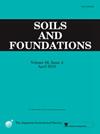Shaping force-transfer arch to retain subsurface cavity in coarse sandy ground
IF 3.3
2区 工程技术
Q2 ENGINEERING, GEOLOGICAL
引用次数: 0
Abstract
Ground cave-ins, which are the collapse and discontinuous subsidence of the ground surface, are thought to be caused by the expansion and upward movement of subsurface cavities due to fluctuations in the groundwater table or earthquakes. Compared to cohesive clays or plastic silts, cohesionless sands are more vulnerable to cavity formation and subsequent ground cave-ins. With recent technology, such as ground-penetrating radar, geometrical information on cavities, e.g., location and shape, can be detected. In practice, the soil cover thickness-to-cavity width ratio () is often used for risk assessments of cave-ins. However, it is questionable whether alone is sufficient for these risk assessments since the mechanical responses, such as the resistance of the remaining soil above the cavity, are not considered. For this reason, the aim of the present contribution is to understand the mechanism underlying the subsurface cavity stability by considering the force transfer around the cavity. Suction measurement, cavity retention, and needle penetration model tests were conducted using various coarse granular materials. The results revealed that suction is essential to preventing cavities from collapsing, and that suction is higher for smaller particles, particles with lower degrees of saturation, and particles with angular shapes and smoother surfaces. In addition to , the mechanical interlock from angularity or roughness contributes to cavity stability. Laboratory needle penetration tests revealed the existence of a force-transfer arch between the sound and weakened zones around a cavity, which is related to the cavity stability. Furthermore, the position of the arch is affected not only by , but also by the particle characteristics (e.g., friction angle) and cavity roof shape. Therefore, considering the material type and the shape of the cavity roof, along with , will lead to enhanced assessments of the cave-in potential of subsurface cavities.
粗砂地基中成形传力拱保留地下空腔
地面塌陷是指地表的塌陷和不连续的下沉,被认为是由于地下水位的波动或地震引起的地下空洞的扩张和向上运动造成的。与粘性粘土或塑性粉砂相比,无粘性砂更容易形成空洞和随后的地面塌陷。利用最近的技术,例如探地雷达,可以探测到空腔的几何信息,例如位置和形状。在实践中,土覆盖厚度-洞腔宽度比(H/B)常用于塌方风险评估。然而,单靠H/B是否足以进行这些风险评估是值得怀疑的,因为没有考虑机械反应,例如空腔上方剩余土壤的阻力。因此,本文的目的是通过考虑空腔周围的力传递来理解地下空腔稳定性的机制。采用不同的粗颗粒材料进行吸力测量、空腔保留和针刺模型试验。结果表明,吸力对防止空腔坍缩至关重要,并且对于较小的颗粒、饱和度较低的颗粒以及棱角形状和表面较光滑的颗粒,吸力更高。除了H/B外,来自角度或粗糙度的机械联锁有助于腔体稳定性。实验室针刺试验表明,在腔体周围的声区和弱区之间存在一个力传递拱,这与腔体的稳定性有关。此外,拱的位置不仅受H/B的影响,还受颗粒特性(如摩擦角)和空腔顶板形状的影响。因此,考虑空区顶板的材料类型和形状,并结合H/B,将有助于加强对地下空区塌陷潜力的评估。
本文章由计算机程序翻译,如有差异,请以英文原文为准。
求助全文
约1分钟内获得全文
求助全文
来源期刊

Soils and Foundations
工程技术-地球科学综合
CiteScore
6.40
自引率
8.10%
发文量
99
审稿时长
5 months
期刊介绍:
Soils and Foundations is one of the leading journals in the field of soil mechanics and geotechnical engineering. It is the official journal of the Japanese Geotechnical Society (JGS)., The journal publishes a variety of original research paper, technical reports, technical notes, as well as the state-of-the-art reports upon invitation by the Editor, in the fields of soil and rock mechanics, geotechnical engineering, and environmental geotechnics. Since the publication of Volume 1, No.1 issue in June 1960, Soils and Foundations will celebrate the 60th anniversary in the year of 2020.
Soils and Foundations welcomes theoretical as well as practical work associated with the aforementioned field(s). Case studies that describe the original and interdisciplinary work applicable to geotechnical engineering are particularly encouraged. Discussions to each of the published articles are also welcomed in order to provide an avenue in which opinions of peers may be fed back or exchanged. In providing latest expertise on a specific topic, one issue out of six per year on average was allocated to include selected papers from the International Symposia which were held in Japan as well as overseas.
 求助内容:
求助内容: 应助结果提醒方式:
应助结果提醒方式:


